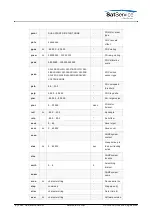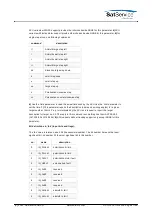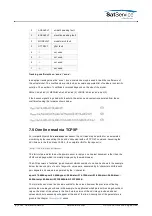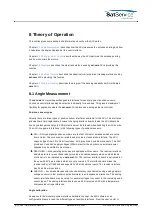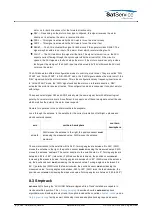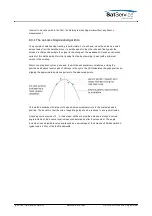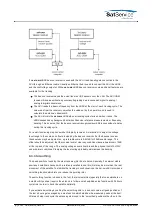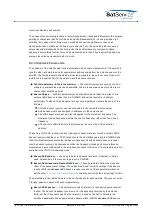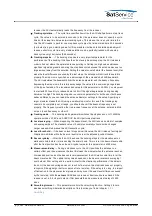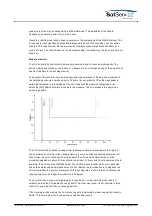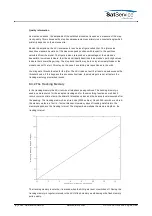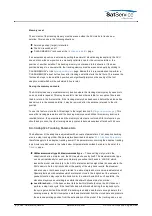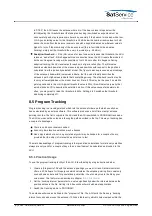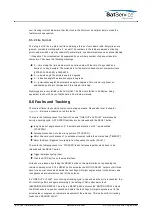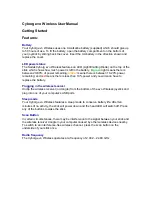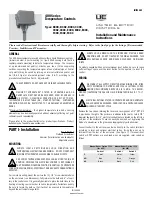
receiver, the ACU automatically reads the frequency from the receiver.
Trackingcycletime --- The cycle time specifies how often the ACU shall perform a step track
cycle. The value is to be entered in seconds. In fact, the parameter does not specify a cycle
time but the sleep time between two tracking cycles. This means, the true cycle time is the
time the ACU needs to perform one step track cycle plus the time entered here. 300 seconds
(5 minutes) is a good starting value for this parameter. Inclined orbit satellites probably will
require a shorter cycle time, very stable satellites can be perfectly tracked with one step
track cycle every 15 minutes (900 seconds).
Trackingstepsize --- The tracking step size is a very important parameter for the
performance of the tracking. It defines the size of every depointing step, the ACU makes in
order to find out where the optimal antenna pointing is. Setting too high values will cause
significant signal degradations during the step track cycle because the antenna moves a too
large amount away from the satellite. Setting the value too small will let the beacon level jitter
mask the level differences caused by the test steps, the antenna will not track the satellite
properly.The step size is specified as a percentage of the antenna's half 3dB beamwidth.
The ACU calculates the beamwidth from the antenna diameter and the beacon frequency.
Expressing the step size in this relative way keeps the value in the same range, regardless
of the type of antenna. The recommended value for this parameter is 15-20%. You may want
to start with 20% and try to reduce down to 15% if the signal degradation during tracking
becomes too high.The tracking step size is a common parameter for both axes. If both axes
behave differently, you can tweak the antenna diameter settings in the setup. Specifying a
larger diameter makes the ACU using a smaller step size for this axis.If the tracking step
seems to be completely out of range, you should check if the beacon frequency is set
properly. The frequency must be the true receive frequency at the antenna, entered in MHz,
not an L-band frequency or other IF.
Trackingmode --- The tracking mode parameter switches the steptrack on or off. With the
operation modes 'STEP' and 'ADAPTIVE' the ACU performs steptrack.
Levelaveraging --- When measuring the beacon level, the ACU takes a number of samples
and averages them. The standard value of 5 samples normally should not be changed.
Larger values will slow down the ACU execution cycle.
Levelthreshold --- If the beacon level drops below this value, the ACU raises a fault signal.
Steptrack is inhibited while the beacon level is too low, the antenna position freezes.
Recoverydelay --- After the the ACU has done the tracking steps for the elevation axis, it
waits some time before it starts tracking the azimuth axis. This is to let the beacon level settle
after the final position has been found. A typical value for this parameter is 4000 msec.
Measurementdelay --- During a steptrack cycle, the ACU positions the antenna to a
certain offset and then measures the level. Between the moment when the antenna reached
commanded position and the beacon level measurement the ACU waits some time to let the
beacon level settle. The optimal delay value depends on the beacon receiver's averaging /
post detector filter setting and is a quite critical for the steptrack performance.If the delay is
too short, the beacon voltage does not reach its final value, the steptrack does not properly
recognize if the signal gor better or worse after a test step. If the delay is too long, the impact
of fluctuation to the measures level grows and may cover the small level difference caused
by the test step. With the sat-nms LBRX beacon receiver, best results are achieved if the
receiver is set to 0.5 Hz post detector filter bandwidth and a measurement delay of 1500
msec.
Smoothinginterval --- This parameter controls the smoothing function. Setting it to zero
disables smoothing. A detailed description of this function you find at chapter
'8.3.3
Smoothing'
(C) 2022, SatService GmbH
www.satnms.com
ACU-19V2-UM-2209 Page 58/65


